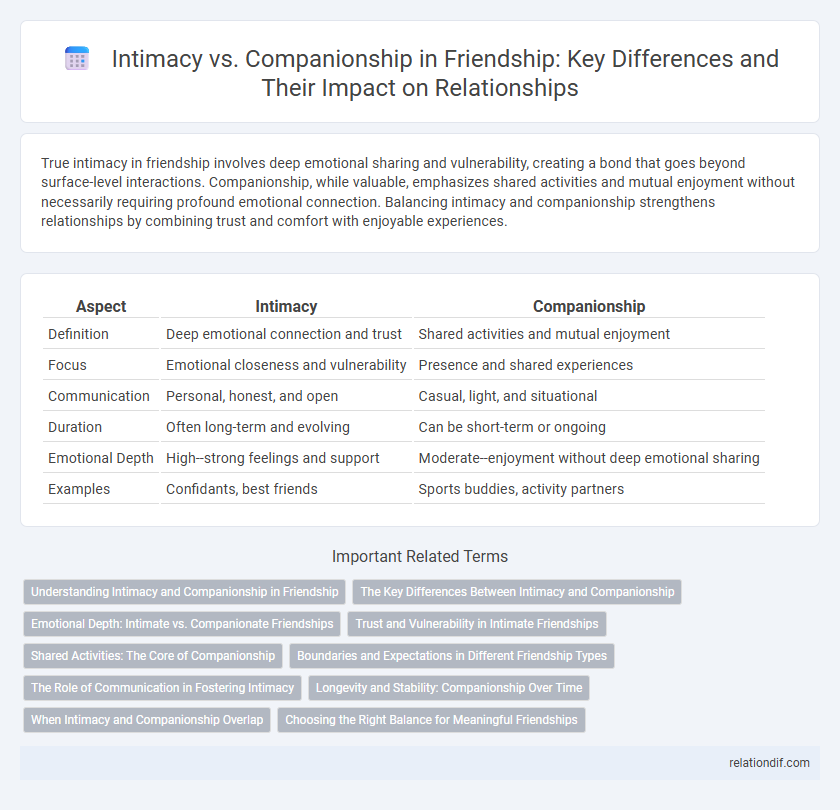True intimacy in friendship involves deep emotional sharing and vulnerability, creating a bond that goes beyond surface-level interactions. Companionship, while valuable, emphasizes shared activities and mutual enjoyment without necessarily requiring profound emotional connection. Balancing intimacy and companionship strengthens relationships by combining trust and comfort with enjoyable experiences.
Table of Comparison
| Aspect | Intimacy | Companionship |
|---|---|---|
| Definition | Deep emotional connection and trust | Shared activities and mutual enjoyment |
| Focus | Emotional closeness and vulnerability | Presence and shared experiences |
| Communication | Personal, honest, and open | Casual, light, and situational |
| Duration | Often long-term and evolving | Can be short-term or ongoing |
| Emotional Depth | High--strong feelings and support | Moderate--enjoyment without deep emotional sharing |
| Examples | Confidants, best friends | Sports buddies, activity partners |
Understanding Intimacy and Companionship in Friendship
Intimacy in friendship involves deep emotional connection, trust, and vulnerability that foster a sense of being truly known and accepted. Companionship centers on shared activities and mutual enjoyment, providing comfort and reliability without necessarily involving profound emotional exchange. Recognizing the distinct roles of intimacy and companionship enhances the quality and balance of friendships, allowing individuals to meet different social and emotional needs.
The Key Differences Between Intimacy and Companionship
Intimacy involves a deep emotional connection characterized by vulnerability, trust, and personal disclosure, while companionship centers on shared activities and mutual support without necessarily revealing inner feelings. The key difference lies in intimacy's focus on emotional closeness, contrasting with companionship's emphasis on presence and shared experiences. Both play crucial roles in friendship, with intimacy fostering deeper bonds and companionship providing consistent social engagement.
Emotional Depth: Intimate vs. Companionate Friendships
Intimate friendships are characterized by profound emotional depth, where trust, vulnerability, and shared personal experiences foster a strong bond. Companionate friendships emphasize mutual support, shared interests, and reliable presence, offering stability without intense emotional exposure. Both forms enrich social connections, but intimate friendships often lead to deeper psychological fulfillment through emotional closeness.
Trust and Vulnerability in Intimate Friendships
Trust forms the foundation of intimate friendships, where vulnerability creates deep emotional connections and mutual understanding. Sharing personal thoughts fosters a safe environment, enhancing emotional support beyond superficial companionship. This blend of trust and openness differentiates intimate friendships from casual relationships.
Shared Activities: The Core of Companionship
Shared activities form the foundation of companionship by creating mutual experiences that deepen bonds beyond surface-level interactions. Engaging in hobbies, sports, or creative projects together fosters trust and understanding, essential elements of intimate friendships. These moments of collaboration and enjoyment build lasting connections that distinguish companionship from mere acquaintance.
Boundaries and Expectations in Different Friendship Types
Intimacy in friendships involves deep emotional sharing and vulnerability, requiring clear boundaries to protect personal well-being, while companionship centers on shared activities and mutual enjoyment with more flexible expectations. Boundaries in intimate friendships often include confidentiality and emotional support limits, whereas companionship thrives on casual interactions without intensive demands. Understanding these distinctions helps maintain healthy dynamics by aligning expectations with the friendship type's nature.
The Role of Communication in Fostering Intimacy
Effective communication serves as the foundation for fostering intimacy in friendships by enabling individuals to share emotions, thoughts, and vulnerabilities openly. This deep exchange promotes trust and understanding beyond surface-level companionship, creating a meaningful emotional connection. Active listening, empathy, and honest dialogue are critical components that transform casual interactions into intimate bonds within friendships.
Longevity and Stability: Companionship Over Time
Longevity and stability in friendship are often rooted in companionship, which fosters consistent support and shared experiences over time. Intimacy, while profound, fluctuates and may not always sustain the enduring nature of true companionship. Stable friendships thrive on mutual reliability and understanding, ensuring long-term resilience beyond transient emotional closeness.
When Intimacy and Companionship Overlap
When intimacy and companionship overlap, friendships deepen through shared trust, emotional vulnerability, and mutual support, creating strong bonds that balance closeness with steady presence. This intersection fosters meaningful connections where friends feel both understood and consistently available, enhancing overall relationship satisfaction. Emotional intimacy combined with reliable companionship strengthens resilience against life's challenges and nurtures long-lasting social ties.
Choosing the Right Balance for Meaningful Friendships
Intimacy in friendship fosters deep emotional connections through shared vulnerabilities and trust, while companionship emphasizes shared activities and mutual enjoyment. Choosing the right balance depends on personal needs and the nature of each relationship, allowing friendships to be both supportive and enjoyable. Meaningful friendships thrive when individuals respect boundaries while cultivating closeness, creating a dynamic interplay between intimacy and companionship.
intimacy vs companionship Infographic

 relationdif.com
relationdif.com